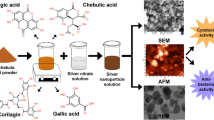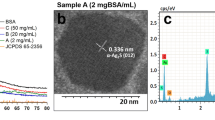Abstract
The aim of this work was to characterize the physico-chemical properties of 3-hydroxyflavone (3-HF) in a silver nanoparticles complex (SNPs) using UV–vis and Fluorescence spectroscopy, Atomic Force Microscopy (AFM) and Transmission Electron Microscopy (TEM) analysis. One also evaluated its effect on the cell viability and morphology of L929 mouse fibroblast cells in vitro. The contribution of the carrier protein, Bovine Serum Albumin (BSA) to 3-HF properties has also been investigated. 3-HF in BSA/SNPs systems presented no cytotoxic effect in L929 mouse fibroblast cells at any of the tested concentrations. The results are discussed with relevance to the oxidative stress process.










Similar content being viewed by others
References
Rusznyak S, Szent-Gyorgi A (1936) Vitamin P: flavonols as vitamins. Nature 138:27. doi:10.1038/138027a0
Takahama U (1983) Suppression of photoperoxidation by quercetin and its glycosides in spinach chloroplast. Photochem Photobiol 38:363–367
Harborne JB (1988) In: Cody V, Middleton E, Harborne JB, Beretz A (eds) Flavonoids in the environment: structure-activity relationship. Alan R. Liss, New York
Lamson DW, Brignall MS (2000) Antioxidants and cancer III: quercetin. Altern Med Rev 5:196–208
William RJ, Spencer JS, Rice-Evans C (2004) Flavonoids: antioxidants or signalling molecules? Free Radic Biol Med 36:838–849
Anderson OM, Markham KR (2006) Flavonoids: chemistry, biochemistry and applications. CRC Press, Boca Raton
Sengupta PK, Kasha M (1979) Excited state proton- transfer spectroscopy of 3-hydroxyflavone and quercetin. Chem Phys Lett 68:382–385
Wolfbeis OS (1985) In: Schulman SG (ed) Molecular luminescence spectroscopy: methods and applications part I. Wiley, New York
Guharay J, Sengupta B, Sengupta PK (2001) Proteins 43:75
Demchenko AP, Ercelen S, Roshal AD, Klymchenko AS (2002) Pol J Chem 76:1287
Sytnik A, Gormin D, Kasha M (1994) Interplay between excited-state intramolecular proton transfer and charge transfer in flavonols and their use as protein-binding-site fluorescence probes. Proc Natl Acad Sci U S A 91:11968–11972
Sytnik A, Litvinyuk I (1996) Energy transfer to a proton-transfer fluorescence probe: tryptophan to a flavonol in human serum albumin. Proc Natl Acad Sci U S A 93:12959–12963
Hussain S, Ferguson C (2006) Best evidence topic report. Silver sulphadiazine cream in burns. Emerg Med J 23:929–932
Bhattacharya R, Mukherjee P (2008) Biological properties of “naked” metal nanoparticles. Adv Drug Deliv Rev 60:1289–1306
Muangman P, Muangman S, Opasanon S, Keorochana K, Chuntrasakul C (2009) Benefit of hydrocolloid SSD dressing in the outpatient management of partial thickness burns. J Med Assoc Thai 92:1300–1305
Caruso DM, Foster KN, Blome-Eberwein SA, Twomey JA, Herndon DN, Luterman A, Silverstein P, Antimarino JR, Bauer GJ (2006) Randomized clinical study of hydrofiber dresssing with silver or silver sulphadiazine in the management of partial thickness burns. J Burn Care Res 27:298–309
Pearce ME, Melanko JB, Salem AK (2007) Multifunctional nanorods for biomedical applications. Pharm Res 24:2335–2352
Xiao Y, Gao X (2010) Use of IgY antibodies and semiconductor nanocrystal detection in cancer biomarker quantitation. Biomark Med 4:227–239
Shrivastava S, Bera T, Roy A, Singh G, Ramachandrarao P, Dash D (2007) Characterization of enhanced antibacterial effects of novel silver nanoparticles. Nanotechnology 18:225103–225112
Uygur F, Oncul O, Evinc R, Diktas H, Acar A, Ulkur E (2009) Effects of three different topical antibacterial dressings on Acinetobacter baumannii-contaminated full-thickness burns in rats. Burns 35:270–273
Muthu MS, Wilson B (2010) Multifunctional radionanomedicine. A novel platforme for effective cancer imaging and therapy. Nanomedicine 5:169–171
Su Y, Qiao S, Yang H, Yang C, Jin Y, Stahr F, Sheng J, Cheng L, Ling C, Lu GQ (2010) Titanate-silica mesostructured nanocables: synthesis, structural analysis and biomedical applications. Nanotechnology 21:065604. doi:10.1088/0957-4484/21/6/065604
Sondy I, Salopek-Sondi B (2004) Silver nanoparticles as antimicrobial agent: a case study on E. Coli as a model for Gram-negative bacteria. J Colloid Interface Sci 275:177–182
Kim JS, Kuk E, Nam Yu K et al (2007) Antimicrobial effects of silver nanoparticles. Nanomed Nanotechnol Biol Med 3:95–101
Wei D et al (2009) The sysnthesis of chitosan-based siver nanoparticles and their antibacterial activity. Carbohydr Res 344:2375–2382
Rai M, Yadav A, Gade A (2009) Silver nanoparticles as a new generation of antimicrobials. Biotechnol Adv 27:76–83
Guzman MG, Dille J, Godet S (2009) Synthesis of silver nanoparticles by chemical reduction method and their antibacterial activity. Int J Chem Biol Eng 2–3:104–111
Wong KKY, Liu X (2010) Silver nanoparticles—the real “silver bullet” in clinical medicine? Med Chem Commun 1:125–131
De Lima R, Seabra AB, Duran N (2012) Silver nanoparticles: a brief review of cytotoxicity and genotoxicity of chemically and biogenically synthesized nanioparticles. J Appl Toxicol 32:867–879
Manke A, Wang L, Rojanasakul Y (2013) Mechanisms of nanoparticles—induced oxidative stress and toxicity. BioMed Res Int. doi:10.1155/2013/942916
Matsuo M, Sasaki N, Saga K, Kaneko T (2005) Cytotoxicity of flavonoids towards cultured normal human cells. Biol Pharm Bull 28:253–259
Voicescu M, Nistor CL, Meghea A (2015) Insights into the antioxidant activity of some flavones on silver nanoparticles using a chemiluminescence method. J Lumin 157:243–248. doi:10.1016/j.jlumin.2014.08.058
Angelescu DG, Vasilescu M, Somoghi R, Donescu D, Teodorescu VT (2010) Kinetics and optical properties of the silver nanoparticles in aqueous L64 block copolymer solutions. Colloids Surf A Physicochem Eng Asp 366:155–162
Craciunescu O, Moldovan M, Moisei M, Trif M (2013) Liposomal formulation of chondroitin sulfate enhances its antioxidant and anti-inflammatory potential in L929 fibroblast cell line. J Liposome Res 23:145–153
Voicescu M, Ionescu S, Angelescu DG (2012) Spectroscopic and coarse-grained simulation studies of the BSA and HSA protein adsorption on silver nanoparticles. J Nanoparticle Res 14:1174. doi:10.1007/s11051-012-1174-0
Voicescu M, Angelescu DG, Ionescu S, Teodorescu VS (2013) Spectroscopic analysis of the riboflavin—serum albumins interaction on silver nanoparticles. J Nanoparticle Res 15:1555. doi:10.1007/s11051-013-1555-z
Benesi HA, Hildebrand JH (1949) A spectrophotometric investigation of the interaction of iodine with aromatic hydrocarbons. J Am Chem Soc 71:2703–2707
Acknowledgments
This work was supported by a grant of the Romanian National Authority for Scientific Research, CNCS – UEFISCDI, project number PN-II-RU-TE-2012-3-0055.
Author information
Authors and Affiliations
Corresponding author
Rights and permissions
About this article
Cite this article
Voicescu, M., Craciunescu, O., Moldovan, L. et al. Physicochemical Characterization and In Vitro Cytotoxic Effect of 3-Hydroxyflavone in a Silver Nanoparticles Complex. J Fluoresc 25, 1215–1223 (2015). https://doi.org/10.1007/s10895-015-1608-z
Received:
Accepted:
Published:
Issue Date:
DOI: https://doi.org/10.1007/s10895-015-1608-z




